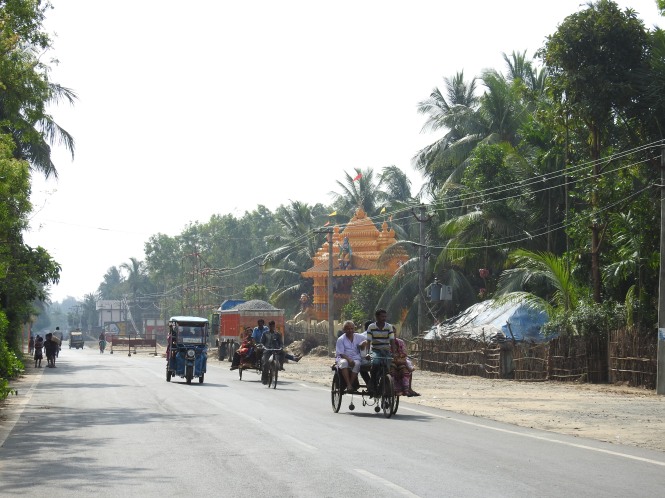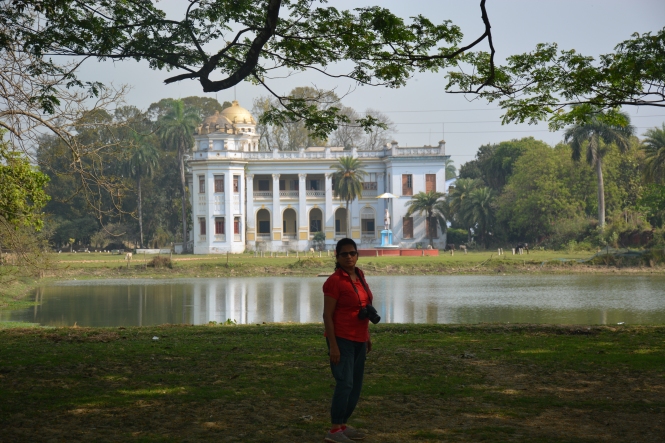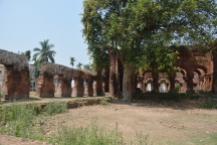The last state of our coastal journey also turned out to be the most difficult. The taste of the things to come is received at the Mahanadi delta in northern Odisha. The same terrain type continues and becomes more muddy and hostile as we proceed to the deltas formed by the Hoogli which meets the sea at various places all along the coastline of the state. Our journey is road based and self-driven. This does not suit the coast of this State. It could better be done using a boat.
Our first stop is Digha, probably the only full-fledged beach holiday location in West Bengal. It is just across the Odisha border and the locals do not seem to be making any distinction between the two states.

Digha is connected to Kolkata by a railway line and that largely explains the large number of tourists flocking here. The 190 Kms rail distance is covered in less than four hours from Howrah Junction. It also explains the presence of large number of hotels and lodges.
We pass this last temple on the Odisha side and cross into the West Bengal. This is the ‘Garuda’, bird ‘vahan’ of Lord Vishnu carrying his master on his wing. This species has now become extinct, in case you are wondering why we are not using this mode of transport now.

There is nothing special about the town and the beach except that they give you a taste of Kolkata. The seashore especially at the Old Digha beach seems to be shored up by pouring concrete. It is being attacked by the sea and would have been eroded without this effort.

The beach is otherwise well maintained and clean and has a lot of monuments:
After a night’s halt and moving around the resort town, we decide to continue into West Bengal. The next town for us to visit is the port city of Haldia. There is no ‘coastal’ road to reach the place. It is 108 Kms. away by the typically narrow roads of West Bengal. It could be shorter if you use a route with a ferry crossing which we avoid. The reasons will be clearer as we proceed with this post. Here is the road out of Digha.

Raising arches seems to be a Bengali obsession as much as raising statues is a Andhraite vice.

Haldia is out and out a commercial town, typical of the new port towns with the numerous heavy industries which have come up because of the port facilities. It was only after we left the place that we realized that we had not taken any pictures at Haldia. It is mid-march and it is getting hotter by the day and tiring.
From Haldia we are heading for Diamond Harbour, across the Hooghli, 62 Kms away but through very dense traffic of what are the outlying areas of the great city of Kolkata. Before we reach Diamond Harbour we have two historical places to visit on the way, neither is very far from the highway leading to Kolkata.
The first one is called Mahishadal Rajbari. Mahishadal is name of a place. Rajbari, I presume with good reason, is a palace or a place occupied by a ruler. This particular Rajbari’s available history states that it is an estate established by a North Indian Businessman with a view to establish a ‘Zamindari’. The businessman, presumably a merchant, with 16th century antiquity is known by the name of Janardhan Upadhyay Garg. What strikes me here is the realization that a ‘Zamindari’ could be ‘established’ by whoever had the means to do so. It was not an evolved, hereditary institution. If true, I don’t blame the English in colonizing India. They just enlarged the concept of the Zamindari into a larger Zamindari.

History apart, this is a beautiful place. I wonder who owns it now. There are two palaces and many other smaller structures on the grounds and beyond is a place where the boys are training themselves to be cricketers. The one attended to and for which one has to pay an admission fee is in the front and has a nice view. It has some old furniture and some stuffed animals which will rot in the near future. Some old guns used in hunting the animals are hanging on the walls. Photography is not allowed inside.
Here are the grounds facing the palace:

The Zamindar:

The old Rajbari at the backside of the one above is not maintained the same way as the new one.

Done with the Rajbari we drive in the opposite direction along a canal and reach the highway at some distance where we had entered and continue north to see another Rajbari, much more interesting than the one we just left. The past of Tamluk Rajbari is not as modest as that of Mahishadal Rajbari.
We pass through very narrow streets of an old town and at one point decide to stop somewhere and take a autorikshaw. Driving through narrow lanes is scary.

Before, during and after the visit to this place I tried desperately to find out something credible about it on the internet . What I have come across is incredible, unbelievable and insulting to intelligence.
The Wikipedia article informs me that this place has been referred to in Puranas and Mahabharata. It is an ancient port, now silted.
‘archaeological remains show continuous settlement from about 3rd century BC’
It is silent on the subject of the Rajbari which is the only major surviving monument. Is the place or the ruins of the building are 2500 years old?

A brilliant piece of information is provided by Holidayfy.com :
‘ …… these ancient ruins of the Tamluk Palace are a brilliant spectacle of architectural brilliance. The temple is believed to be 2500 years old and was inhabited by a West Bengal King’.
This is absolutely brilliant. To my knowledge Palace and temple are two different things. The writer for the website does not make such silly distinctions. West Bengal came into existence with the partition of Bengal by the British and no kings were allowed to exist here (except of course the British monarchs) by them or by the later Communist rulers of the state. Even now the place does not have a King. Having a Queen is a different matter altogether.
We move on to Haldiatourism.gov.in. This is a website maintained at the taxpayers’ cost. It is a government website which states that this place is :
‘……a quiet witness to a glorious history of over 2500 years. Tamluk Rajbari houses rich culture, heritage and legacy’
The only thing this place houses is stray cows and goats. Auto rickshaws drive through it. It does not even have a compound.
The writer continues (and I am sure he has never visited the place. He is sitting somewhere in Kolkata in an air-conditioned room):
‘Believed to be built in the 5th century (BC) by the Mayuradha dynasty, the then king was believed to be present in the Swayambhar Sabha of Draupadi of Mahabharata’
‘the magnificent palace leaves the visitors spellbound’,
perhaps by the smell of urine and cow dung’.
It continues:
‘during Freedom Struggle Mahatma Gandhi and Netaji Subhash Chandra Bose visited the place’
Agreeing to visit this place appears to be among the very few things these two great men agreed upon. Even then, I am sure they visited the place at two different times.
The website Holidayiq.com has reworded the above information by someone perhaps sitting in Mumbai or Delhi. The major and exceptionally brilliant change made in the text is to refer to Draupadi as ‘Lady Draupadi’, stopping just short of calling her Mademoiselle Draupadi or ‘Draupadi Didi’ to keep in line with the more recent political climate.
I am frustrated. I am aware of Indians’ disregard and apathy to history and I am shocked that the British sources do not throw much light on this either. They were here. The White Man was very much in this area. The clergy was here, in fact it is said that this place, Midnapore district , is where the Christian conversions started on the sub-continent outside of the Portuguese influence.
I am no Historian or archaeologist by any stretch of imagination but when I see an arch and when I see a brick I can very well decide if those items are 2500 years old or not. The brickwork and the arches suggest European influence.
Assuming that this ‘Rajbari’ is 2500 old, why are the not ASI here. They are guarding places much younger. What happens to the state Archaeology department. If they don’t do much else they should at least object to the articles on the internet which are misguiding the public.
Not satisfied with what I saw and what I read, I am sceptical. I start talking to the people, including the guy who brought us here in an autorickshaw as we could not locate the place on the narrow road.
‘is this the Rajbari?’
‘Yes’
‘is this the only Rajbari here?’
‘yes, this is the only rajbari’
‘is there any other old, historical place around here?’
‘No, there is none.’
This guy looked educated and could speak Hindi (which is not to be taken for granted in Bengal) and even a smattering of English. He was very sure. I spoke to another person in the town for confirmation. And if you check on the images available on the internet, they are the same as I have posted. I want to rule out the possibility that I drove into a wrong place which my wife always say I do.
My conclusion: This is a fraud caused by ignorance.There is no significant commercial activity suggesting an attempt to divert tourist traffic here.
The Tamluk Rajbari will remain a mystery to me until I find better sources of information about it. The seeds of doubt about what appears on the internet has been sown in my mind very firmly now.
We drive through the urban areas surrounding Kolkata city with a view to stop at Diamond Harbour, avoiding the inner city. Our next stop is to be the islands in the Bay of Bengal which are on the western side of the Sundarbans.
Views of the Hooghli from the riverside hotel we stayed at Diamond Harbour:
Diamond Harbour was only a technical halt to reach Sagar Island and places beyond to the southernmost areas facing the Bay of Bengal. I think I decided on Diamond Harbour because the name was ingrained on my mind.In my childhood I used to follow politics and elections. The name ‘Diamond Harbour’ came up every once in a while as the constituency from where Jyoti Basu won with a such and such huge margin of votes.
We actually tried for the Sagar Island on our way back from Bakkali but for the sake of geographical continuity let me take that up first.
The 80 Kms. drive from Diamond Harbour to Bakhali through the lovely Bengali villages is something one should not miss. I heard you saying it would take about 2 hours. Did I? It could take about 5 times as much. But that is for the next post. Right now we are at a place called Kakdwip which is the gateway to the Sagar island. You can see these places on the map below:

The red circle in the map above is where you are required to cross a ferry. It will appear in the next blog post.
Our objective is to visit the western side of the Sagar Island so that we sort of connect to Haldia on the other side of the river where we have already been.
Kakdwip is a difficult place, believe me. I have seen many of them on this coastal tour. Finding a place to stay is only a minor problem. When it comes to visiting Sagar, the problems just multiply. There are only two crossing points. One ferry takes only passengers and the other one takes vehicles. The latter one makes only one trip a day. It carries the food supply lorries and one might have to wait in the Q for up to a week.
We park our car in the compound of the lodge where we have put up and go around the town exploring the ways and means of visiting Sagar Island. The obvious places to go to are the ferry points.
We first go to the place from where the passenger ferry operates. There has been some problem. One trip was cancelled and it has resulted in a large number of passengers stranded on the jetty. It is late afternoon and the people have to get across to their homes on the island.
From this point one reaches a place called Kakuberia and then make a road journey of 32 Kms. to reach the main town in the island called Gangasagar.
The main religious attraction of the island is the Kapilmuni Temple. This pilgrimage centre is visited by large number of Hindu pilgrims on the 14th of January every year. This is the day they bathe in the waters of the Holy Ganges ( Hoogli here) at it’s confluence with the Bay of Bengal. In fact this is considered as the end-point of the great and holy Ganga. To think of it, all the sins dissolved in the waters of the Holy river by the Hindus living upstream come up to here to be dumped into the Bay of Bengal and make the river free to bring in more sins in the next season from the northern and eastern India. The waters of the Bay of Bengal further east have a high concentration of sins on which the Royal Bengal Tiger feeds.
It was later afternoon when we reached the jetty where the passengers were waiting for the ferry. There was no possibility of visiting the island and returning that day. We decide to try to cross by the car ferry the next day and go to the car ferry point which is at a different place.

The ferry operations are possible only at high tide and hence there can be only two trips to and from the island. We roughly calculate the number of vehicles the ferry can take and the number of vehicles queued up for the next trip. We might have to stay in the queue around two days if we park the car in the queue at that point in time. We are not able to calculate the time needed to return. After considering all aspects we drop the idea of visiting the island. We just enjoy the sunset and return to the lodge for the night halt.

Text by Suryakiran Naik
Pictures by Suryakiran Naik & Veena Naik.














